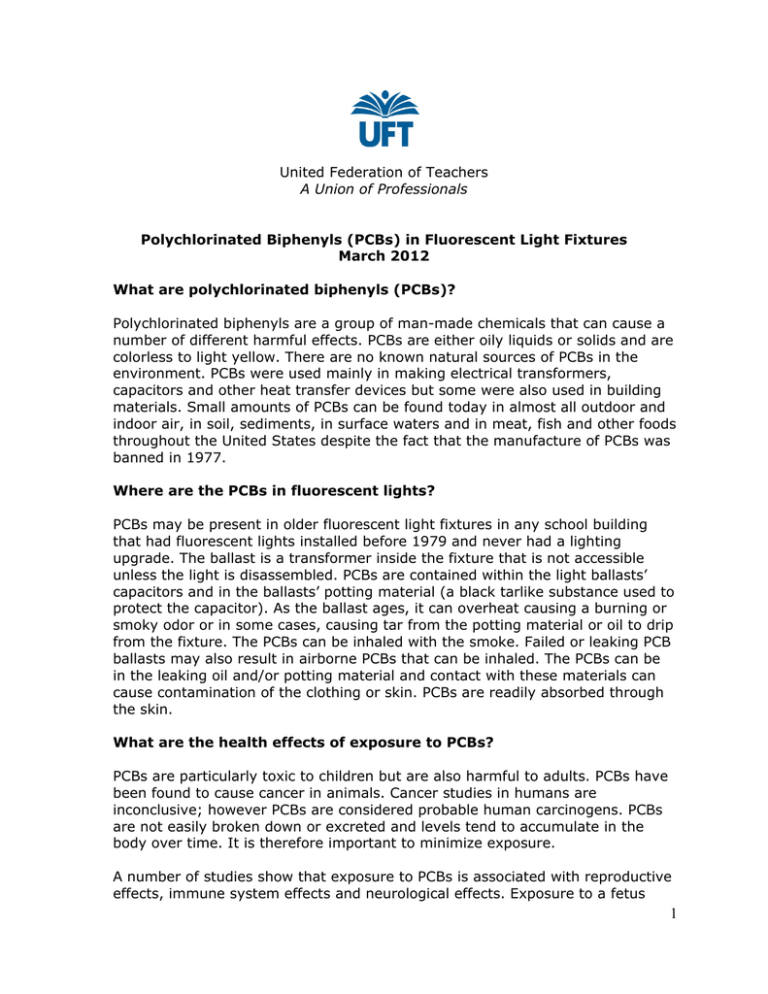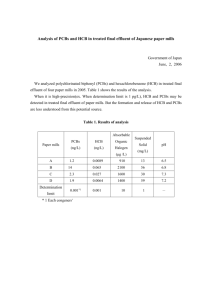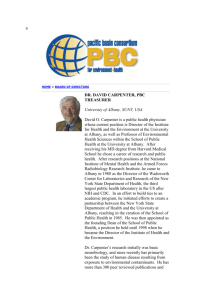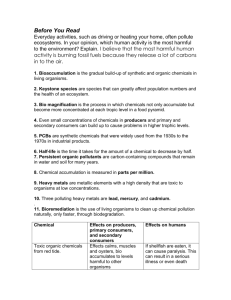United Federation of Teachers A Union of Professionals
advertisement

United Federation of Teachers A Union of Professionals Polychlorinated Biphenyls (PCBs) in Fluorescent Light Fixtures March 2012 What are polychlorinated biphenyls (PCBs)? Polychlorinated biphenyls are a group of man-made chemicals that can cause a number of different harmful effects. PCBs are either oily liquids or solids and are colorless to light yellow. There are no known natural sources of PCBs in the environment. PCBs were used mainly in making electrical transformers, capacitors and other heat transfer devices but some were also used in building materials. Small amounts of PCBs can be found today in almost all outdoor and indoor air, in soil, sediments, in surface waters and in meat, fish and other foods throughout the United States despite the fact that the manufacture of PCBs was banned in 1977. Where are the PCBs in fluorescent lights? PCBs may be present in older fluorescent light fixtures in any school building that had fluorescent lights installed before 1979 and never had a lighting upgrade. The ballast is a transformer inside the fixture that is not accessible unless the light is disassembled. PCBs are contained within the light ballasts’ capacitors and in the ballasts’ potting material (a black tarlike substance used to protect the capacitor). As the ballast ages, it can overheat causing a burning or smoky odor or in some cases, causing tar from the potting material or oil to drip from the fixture. The PCBs can be inhaled with the smoke. Failed or leaking PCB ballasts may also result in airborne PCBs that can be inhaled. The PCBs can be in the leaking oil and/or potting material and contact with these materials can cause contamination of the clothing or skin. PCBs are readily absorbed through the skin. What are the health effects of exposure to PCBs? PCBs are particularly toxic to children but are also harmful to adults. PCBs have been found to cause cancer in animals. Cancer studies in humans are inconclusive; however PCBs are considered probable human carcinogens. PCBs are not easily broken down or excreted and levels tend to accumulate in the body over time. It is therefore important to minimize exposure. A number of studies show that exposure to PCBs is associated with reproductive effects, immune system effects and neurological effects. Exposure to a fetus 1 during pregnancy has been linked to developmental effects on young children including decreased intelligence, memory and attention span. To date, there is no evidence to conclude that there are harmful effects to a developing fetus from short-term exposure to PCBs at levels demonstrated in school buildings with PCB light ballasts. The U.S. Environmental Protection Agency (EPA) has established recommended airborne exposure levels (benchmark levels) for schools. Because PCBs accumulate in the body, these levels are designed to protect children from chronic, long-term exposure to low levels of airborne PCBs. PCB pilot study in 3 NYC public schools during summer 2010 and 5 NYC public schools during summer 2011 The School Construction Authority (SCA) conducted the first phase of a pilot study on exposure to PCBs in three schools in the summer of 2010 as per a Consent Agreement and Final Order with the U.S. Environmental Protection Agency. The purpose of the study was to evaluate the risk of PCB exposure to school occupants caused by PCB-containing caulking. The result of the first phase of testing revealed that PCB levels in air can become elevated above U.S. EPA benchmark levels for schools. Lighting fixtures which had PCB fluorescent lighting ballasts that failed and leaked PCBs surfaced as a significant problem according to the U.S. EPA Region 2. The SCA’s air testing results indicated that removal and replacement of these lighting fixtures resulted in substantial reductions in PCB airborne concentrations in these three pilot school buildings. During the summer of 2011 the SCA continued the pilot study in the three schools studied the previous summer as well as two additional schools. Each school is in a different borough. The SCA’s air testing results demonstrated once again that removal of light fixtures had the most profound effect on reducing airborne PCB levels. Wipe samples of surfaces were also taken and analyzed for PCBs. Wipes sample results indicated there is no significant PCB contamination of surfaces. What is the hazard? Intact light ballasts do not appear to present an immediate risk of exposure to PCBs, but leaking, overheated or burning ballasts release PCBs. While intact PCB-containing ballasts pose no immediate health threat, they are likely to fail over time. The NYC School Construction Authority (SCA) has posted a list of the 740 buildings it has identified as having lighting fixtures containing PCBs: Survey of School Buildings with Older T-12 Flourescent Lighting Fixtures (PDF) Plan to remove and replace PCB-containing light fixtures 2 The UFT has been outspoken regarding the need to remove and replace PCB light fixtures. In response to pressure from the UFT, the US EPA, local and state elected officials and other organizations the DOE, in February 2011, implemented a plan to remove and replace PCB-containing light fixtures in the 740 schools over a ten-year period. The UFT continues to urge the City and the DOE to implement a more aggressive removal plan that completes the removal and replacement of PCB fluorescent light fixtures in two years but certainly no more than five years. The NYC School Construction Authority (SCA) has posted a list of schools where PCB light fixtures have been removed and replaced with fixtures that do not contain PCBs: Completed Lighting Fixture Replacements (PDF) What does it mean when a light fixture has been removed from a classroom or other space in the school building? The DOE has notified every custodian to visually inspect every light fixture in the school. When a light fixture is observed with tar or oil stains on the fixture or plastic lens of the light, an expedited work order is generated and a hazardous materials company will conduct an inspection and quickly remove the ballast and possibly the entire fixture when the room is unoccupied. You may notice a fixture is suddenly missing in your classroom or other space. It is possible that the custodian requested the removal. This means that the ballast has leaked. The presence of past leaks does not mean the staff or students have been exposed to PCBs. The leak could have happened many years ago and it may or may not have created airborne PCBs. However, there is no way to estimate past exposures to PCBs. The NYC School Construction Authority (SCA) website lists schools where custodial engineers and building managers have reported visible stains or other signs of PCB leaks from the light fixtures. All fixtures where visible leaks were observed have been removed and replaced with fixtures that do not contain PCBs. The schools will be given higher priority for light fixture replacements than other school buildings where no visible leaks have been found. Buildings with Visible Leaking PCB Ballasts (PDF) Will air samples or surface wipe samples be collected in a classroom or space where a leaking ballast has been removed? Currently, the DOE has not conducted air sampling or surface sampling during or after the removal of a leaking ballast or light fixture. However, spot testing and the pilot study have indicated that removing leaking light ballasts or light fixtures will reduce levels of PCBs in air. The DOE has used the EPA benchmarks for measuring PCBs in air and on surfaces for the pilot study and for assessing cleanup work on a limited basis. The air sample limits set by the EPA were set with many safety factors for the purposes of protecting school children. Schools 3 with airborne PCB levels that are at or above the benchmarks do not represent an immediate health risk. The EPA did not recommend that these schools be evacuated. Medical tests All people in industrial countries have some PCBs in their bodies. There are tests to determine whether PCBs are in the blood and body fat; however, every person will show some level. There are no standard reference levels to define a normal level of exposure to PCBs. As such, levels of PCBs in blood are difficult to interpret. When PCB-containing caulk first became a concern, the UFT contacted the National Institute for Occupational Safety and Health (NIOSH) regarding whether pregnant staff members should get blood tests for PCB levels. NIOSH responded that “blood levels of PCBs are not useful in guiding decisions about health care during pregnancy and there is insufficient information to determine what values can be interpreted as safe or unsafe. Blood tests for PCBs are not helpful in determining the source of environmental exposure since PCBs can be found in food as well as most buildings (including schools, homes and apartment buildings) built between 1940 and 1977.” Emergency situation If a fluorescent light fixture begins to smoke, if oil is dripping from the light or if you smell an electrical burning odor, the room should be evacuated. Follow the notification procedures for your school and also notify your UFT chapter leader who, in turn, will notify the UFT. Arrangements will be made to inspect the light fixture. The room should be ventilated and may require extensive cleaning before it is safe to occupy. A checklist for PCBs in schools: What to look for If your school has pre-1979 fluorescent light fixtures that have never been upgraded, assume these fixtures contain PCBs. Below is a short list of warning signs that may indicate a PCB leak or problem with the fluorescent light fixtures in your school. • • • • • Burned-out lights that do not work even if the bulbs are changed. Evidence of brown, oily stains on the light fixture itself or on the glass lens of the fluorescent light fixture. Evidence of oil stains on floor tiles or carpeting beneath the lighting fixture. Past episodes of smoke or burning odors that required the custodian to service the lights. Past episodes in which the custodian had to remove a light fixture or take it apart to replace electrical parts. Ventilation 4 Is the ventilation system in your school turned on and working? An inoperable ventilation system will exacerbate any problems. Report what you find Please follow the reporting procedures for your school to report any of the above checklist conditions to your school custodian and to your chapter leader who, in turn, will notify the UFT Safety and Health representative at your UFT borough office. 5



